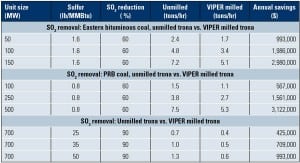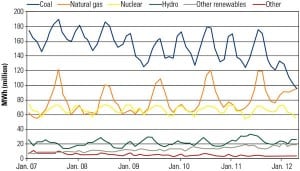COAL POWER Direct
-
O&M
Give Your Plant a Dust Control Tune-Up
Because Powder River Basin (PRB) coal is smaller, more friable, and contains more fine particulates than bituminous coal, controlling the fugitive dust generated as PRB coal moves from bunker to burner tip is problematic. The challenge for material-handling systems at power plants that have switched coals is to minimize this dust and capture it cost-effectively and without compromising safety.
-
Commentary
War Against Coal Is Hurting America
The Boilermakers union has been a leader among the labor and business organizations that seek to shepherd the coal-fired energy sector through the worst effects of these forces. And we continue in those efforts.
-
Commentary
Leave Energy Upgrades to the Businesses
President Obama’s Executive Order on industrial energy efficiency is another incursion of the federal government into the day-to-day operations of American industry. The symbol of a free enterprise is autonomy in determining how to efficiently invest capital, an activity that the government has proven inept time and again.
-
Commentary
Act Your Age
The American Wind Energy Association’s number one priority is renewal of the production tax credit in order to protect industry jobs. But wind isn’t the only industry sector that’s scrambling to protect jobs.
-
Coal
Design Features of Advanced Ultrasupercritical Plants, Part III
Advanced ultrasupercritical (A-USC) is a term used to designate a coal-fired power plant design with the inlet steam temperature to the turbine at 700C to 760C. In the first two parts of this three-part report, we introduced the A-USC boiler and the metallurgical advancements required for the A-USC boiler to operate at such high temperatures. This final report explores the A-USC boiler’s unique design challenges.
-
O&M
In-Line Sorbent Milling Improves Dry Sorbent Injection Performance
Complying with air emissions rules doesn’t always require construction of a scrubber or SCR. Finely ground trona has proven to be very successful at economically removing SO3, SO2, and HCl from stack gases.
-
Coal
Federal Court Rejects Challenges to EPA Industrial, Automotive GHG Rules
A three-judge panel of the U.S. Court of Appeals for the D.C. Circuit on June 26 ruled that the U.S. Environmental Protection Agency (EPA) was "unambiguously correct" in its interpretation of the Clean Air Act (CAA) to regulate carbon dioxide emissions. The federal agency’s endangerment finding that greenhouse gases (GHG), including carbon dioxide, are a threat to public health and welfare, and its decision to set limits for industrial and automotive emissions of GHGs, was "neither arbitrary nor capricious," the court ruled. The court, however, found that it lacked jurisdiction to review the timing and scope of the GHG rules that affect larger stationary sources, including new coal-fired power plants.
-
Coal
EPA Proposes Clean Air Standards for PM2.5
In response to a court order, the U.S. Environmental Protection Agency (EPA) proposed updates on June 15 to its national air quality standards for harmful fine particle pollution, including soot (known as PM2.5). The agency says that 99% of U.S. counties are projected to meet proposed standards without any additional actions.
-
O&M
Coal Could Regain Ground from Gas as Summer Demand Ramps Up
Natural gas-fired generation enjoyed a competitive advantage through this past winter and spring as historically low prices for the commodity combined with mild weather and relatively light demand to turn the dispatch stack on its head and favor gas over coal. That advantage is narrowing as summer demand approaches. A senior market analyst with Bentek Energy expects coal-fired generation to be advantaged at least until the fall shoulder season.
-
Commentary
Changing of the Guard
Preliminary data published by the Energy Information Administration shows that the amounts of power generated by coal and natural gas in April were virtually equal. Was this a one-time event or an indicator of a future trend?




